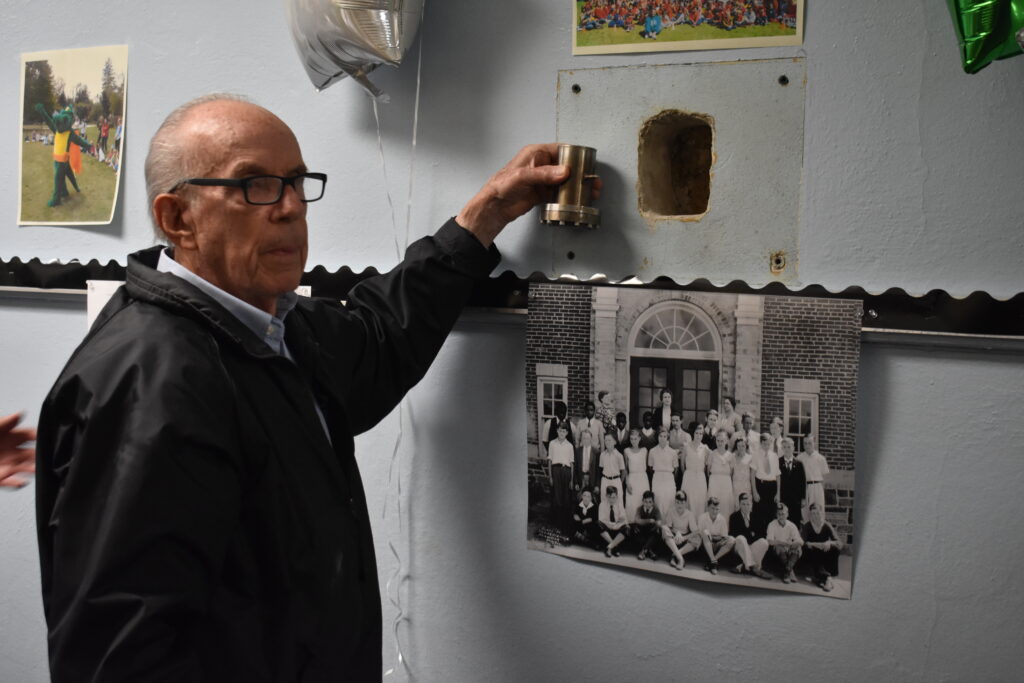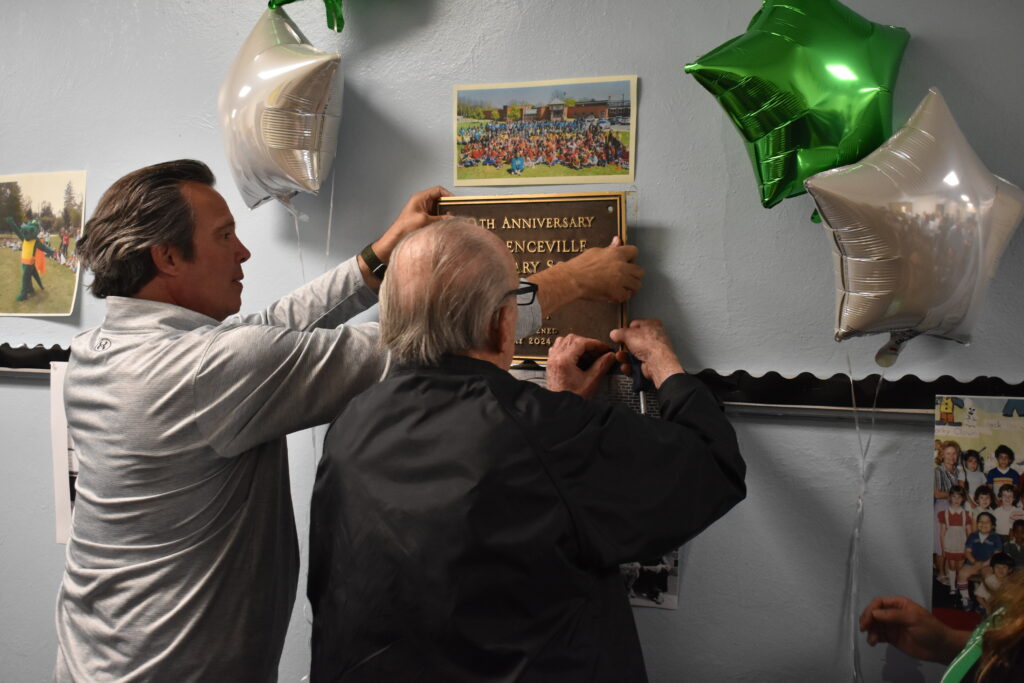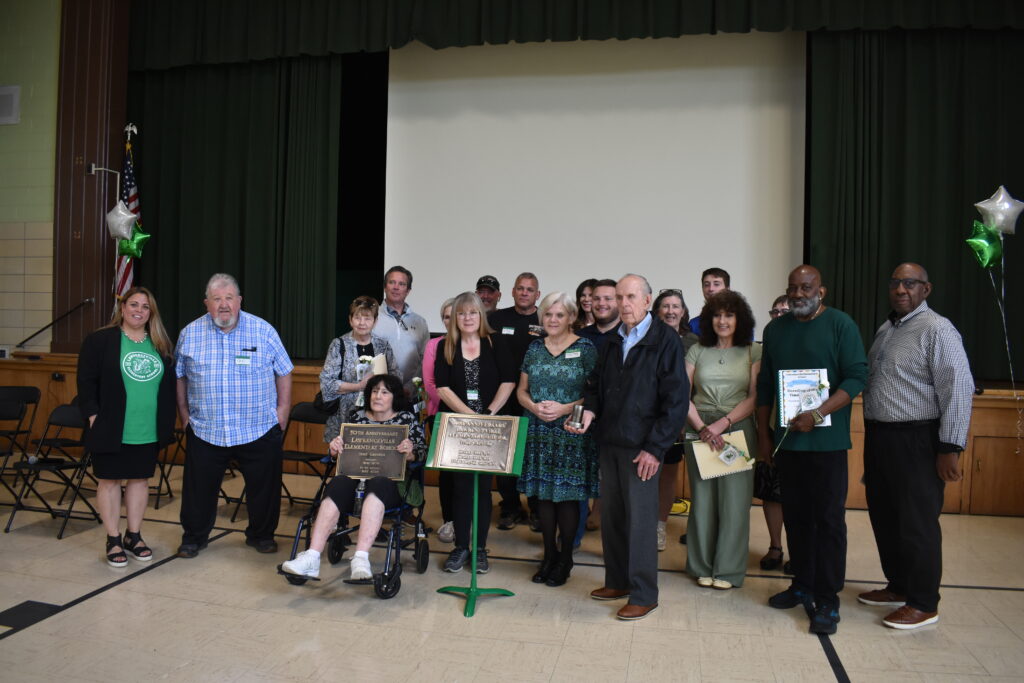A time capsule containing preserved images from 1974 has stood the test of time after 50 years thanks to engineering and inert gas.
Taken from a small hole in the wall of Lawrenceville Elementary School (LES) near the original entrance of the school, the time capsule was unveiled to alumni; families; one of the creators of the time capsule; and LES students in a ceremonial opening on May 30.
A plaque, which had to be unscrewed to reveal the time capsule, stated the time capsule was sealed in May 1974 for the schools 50th anniversary and was to be opened in May 2024.
“In 1974 there was a big party for the 50th year anniversary … all of the students put memorabilia and pieces of their work in a bigger box as well as a time capsule,” LES Principal Melissa Lockett said.
“In the time capsule there was microfilm from all of 50th year events and student work. (The time capsule) was originally placed in the outside of exterior of the (LES) building in 1974.”
They are unsure as to why the time capsule was moved inside the school. Before the ceremonial opening of the time capsule in May, officials wanted to make certain the time capsule and any other items were in the hole, so they opened it in the fall.
“What we found was that there was a metal capsule with the microfilm but none of the student work or memorabilia was in there anymore,” Lockett said. “Most of the images from the microfilm are from that 50th year party and then some images of the student work.”

James Woodyard (left) holds up the time capsule next to the hole in LES wall.
When the school celebrated its 100th year in the fall with students and families, alumni felt strongly that the time capsule could not be unveiled until May 2024.
The time capsule was originally placed in the outside cornerstone of the original LES building. There currently is a patched-up hole in the cornerstone of the original building, which is now the entrance to a faculty room.

Patched cornerstone where the time capsule is believed to be originally moved from on the outside of original LES building entrance.
The history of the original building for LES dates back to 1924.
What was supposed to be in the space in hard copy form in addition to the time capsule was a sample of each child’s work, minutes of the Anniversary Committee meetings, publicity clippings, the souvenir booklet, pictures of celebration activities and guest book signatures.
The time capsule was opened prior with the help of April Oliver, LES media specialist and librarian. The school was able to get the microfilm within the time capsule and the 400 picture images from the 50th anniversary party and student work in 1974.
Oliver had to go to the New Jersey State Library in Trenton and use a microfilm machine that could electronically save all of the pictures. The children’s artwork was labeled with their names.
“There was 35mm (millimeter) film in the time capsule preserved beautifully,” she said. “I had to make an appointment to the New Jersey State Library and spent a couple days there.
“They had a machine that would show me the microfilm and I could scan it and edit it (lighten it up) and save it to a USB. A lot of libraries don’t have that anymore.”
Oliver spent time cataloging all of the items and pictures on the microfilm. It took Oliver three full working days in April to get the images from the microfilm.
“There were 400 frames, and I made a list of what each frame was, and it took a couple days, but it was really interesting,” she said. “There was a level of care that they took when they placed this original time capsule.
“The best part for me was scanning the children’s artwork. The kids drew pictures and wrote messages.”
Oliver’s favorite parts were that students in 1974 had predictions for the future.
“One of them had a library prediction where the library of 2024 was going to be a robot,” she recalled. “You would put your book in a tube and the robot would take care of it.
“The child wrote at the end I hope there are still hardworking people in 2024. Another envisioned what a classroom would look like in 2024. I laughed at that one. Kids were sitting in La-Z-Boy chairs with a big screen that said teach yourself.”
The microfilm containing all of the images would not have been well preserved without the work of two men in the creation and function of the capsule.
James Woodyard built the time capsule with George D. Martin Jr.
“[George] was at Princeton Plasma Physics Lab (PPPL) at the time and I was at what was Trenton State in those days,” Woodyard said. “We met and got this idea for the time capsule. We brought out experimental techniques to this because we both were using vacuum technology in our research.”
He explained that they flushed the capsule with an inert gas, which does not react with many substances, after they got everything in it. Without the inert gas decomposition happens faster with the item being preserved.
They then bolted the capsule tight.
Woodyard said the time capsule would not have been possible without Martin. He noted, “What he has done is being carried forward. This was an experiment, and we were a team.”
Woodyard is a father of one of the students at LES who put their work in the capsule. His son Michael Woodyard’s artwork was one of the images pulled from the microfilm.

Michael Woodyard (left) helps his father James Woodyard (center) take off the plaque covering the time capsule on May 30.
Martin was responsible for the inert gas that was used in the time capsule which allowed for the microfilm to be preserved.
“You can see all the engineering that went into it to create the capsule and putting the inert gases into it made the time capsule perfect for survival,” said Pam Mills, Martin’s daughter. “The most exciting part for me was seeing the time capsule itself and seeing how it was built and to know everything inside was preserved.”
In attendance to watch the time capsule opening was Susan Rooney, who taught at LES for 40 years and was at the school when the time capsule was put in.
“This was a nice event and I have very fond memories of the school and what we did,” Rooney said. “It was very exciting to be a part of this.”
Current LES students will be the next students to have their work preserved for the next 50 years as they completed a special project on past, present and future.
The students for the project created pictures or wrote messages on 100 years ago, about what life must have been like, on what life is like currently, and on what things will be like in 50 years.
The new plaque will say the time capsule cannot be opened until 2074.
“We have to scan all their work,” Lockett said. “Right now, their work is posted around the building. Our plan is to scan every piece and put it in a zip drive. Hopefully, they can read [the zip drive] 50 years from now.”
The principal praised School secretary Jane Tomsho, Office assistant Anne Testa, Classroom assistant Denise Tonzillo and the school’s PTO (Parent Teacher Organization) for their work as the school celebrates its 100th year.

1974 time capsule opening at Lawrenceville Elementary School in Lawrenceville on May 30.
